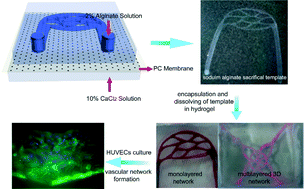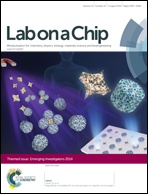Engineering interconnected 3D vascular networks in hydrogels using molded sodium alginate lattice as the sacrificial template†
Abstract
Engineering 3D perfusable vascular networks in vitro and reproducing the physiological environment of blood vessels is very challenging for tissue engineering and investigation of blood vessel function. Here, we engineer interconnected 3D microfluidic vascular networks in hydrogels using molded sodium alginate lattice as sacrificial templates. The sacrificial templates are rapidly replicated in polydimethylsiloxane (PDMS) microfluidic chips via Ca2+-crosslinking and then fully encapsulated in hydrogels. Interconnected channels with well controlled size and morphology are obtained by dissolving the monolayer or multilayer templates with EDTA solution. The human umbilical vein endothelial cells (HUVECs) are cultured on the channel linings and proliferated to form vascular lumens. The strong cell adhesion capability and adaptive response to shear stress demonstrate the excellent cytocompatibility of both the template and template-sacrificing process. Furthermore, the barrier function of the endothelial layer is characterized and the results show that a confluent endothelial monolayer is fully developed. Taken together, we develop a facile and rapid approach to engineer a vascular model that could be potentially used in physiological studies of vascular functions and vascular tissue engineering.

- This article is part of the themed collection: 2014 Lab on a Chip Emerging Investigators

 Please wait while we load your content...
Please wait while we load your content...